Intraspecific Relations: Cooperation and Competition
Background
 Intraspecific interactions
are interactions among organisms of the same species. Members of a group
must be able to communicate with each other to stay in touch with others in
the group. Many animals use vocal communication of some sort while both
plants and animals use various chemical signals to communicate with each
other. In animals, these chemicals are generally called
pheromones
and are used for chemical communication over a distance (these are analogous
to hormones within the body). There are various kinds of pheromones
including things like sex pheromones in a variety of insects (used in gypsy
moth traps), trail pheromones in ants (remember the ants in It’s a Bug’s
Life following the trail?), alarm pheromones in ants (and probably some
other insects, too), and others in other animals, including humans. Plants
often secrete inhibitory chemicals into the surrounding soil to prevent the
growth of other plants nearby. This is called
allelopathy.
Amur Honeysuckle and Black Walnut are two species that are especially
notorious for producing allelopathic chemicals.
Intraspecific interactions
are interactions among organisms of the same species. Members of a group
must be able to communicate with each other to stay in touch with others in
the group. Many animals use vocal communication of some sort while both
plants and animals use various chemical signals to communicate with each
other. In animals, these chemicals are generally called
pheromones
and are used for chemical communication over a distance (these are analogous
to hormones within the body). There are various kinds of pheromones
including things like sex pheromones in a variety of insects (used in gypsy
moth traps), trail pheromones in ants (remember the ants in It’s a Bug’s
Life following the trail?), alarm pheromones in ants (and probably some
other insects, too), and others in other animals, including humans. Plants
often secrete inhibitory chemicals into the surrounding soil to prevent the
growth of other plants nearby. This is called
allelopathy.
Amur Honeysuckle and Black Walnut are two species that are especially
notorious for producing allelopathic chemicals.
Care of Young
Reproductive strategies used by organisms fall into one of
two categories, based on the time and energy invested in rearing young.
Note that these are species-specific traits, and species (populations,
individuals) do not switch back-and-forth between them.
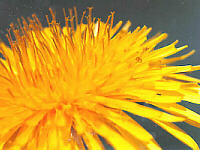 In r-selection/r-strategy, the organism typically lives in a harsh,
unpredictable environment where mortality is independent of population
density (they die anyway). With characteristics typical of the rising
portion of the logistic curve, these species allocate more energy to
reproduction and less to growth and maintenance. Typically, they exhibit
rapid development and early maturity. Most only reproduce one time and
produce a large number of offspring to make up for the large number of
offspring which die. In animals, there is minimal, if any, parental care of
the young, and in plants, seeds are provided with minimal stored food.
In r-selection/r-strategy, the organism typically lives in a harsh,
unpredictable environment where mortality is independent of population
density (they die anyway). With characteristics typical of the rising
portion of the logistic curve, these species allocate more energy to
reproduction and less to growth and maintenance. Typically, they exhibit
rapid development and early maturity. Most only reproduce one time and
produce a large number of offspring to make up for the large number of
offspring which die. In animals, there is minimal, if any, parental care of
the young, and in plants, seeds are provided with minimal stored food.
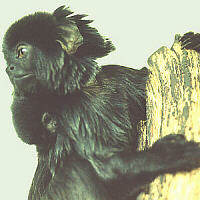 In K-selection/K-strategy, the organism typically lives in a stable,
predictable environment where mortality is related to population density (if
overcrowded, more die due to increased competition). With characteristics
typical of a population maintained at carrying capacity (hence the
K), these species allocate more energy to non-reproductive activities.
Typically they exhibit delayed reproduction (later in life) with slower
development and a longer life span. There is repeated reproduction with
only a few offspring produced each time. In animals, there is often parental
care of the young, and in plants, seeds are produced with much stored
food.
In K-selection/K-strategy, the organism typically lives in a stable,
predictable environment where mortality is related to population density (if
overcrowded, more die due to increased competition). With characteristics
typical of a population maintained at carrying capacity (hence the
K), these species allocate more energy to non-reproductive activities.
Typically they exhibit delayed reproduction (later in life) with slower
development and a longer life span. There is repeated reproduction with
only a few offspring produced each time. In animals, there is often parental
care of the young, and in plants, seeds are produced with much stored
food.
Social and Colonial Animals

(note queen in upper left
with red spot on thorax)
Dr. E. O. Wilson is one of the main people doing research on colonial animals.
Colonial living has advantages and disadvantages. It is a possible source of
heightened competition if resources are limited. Typically a worker in a
colonial species is sterile and not able to pass along her own genes.
However, it has been suggested by some that, since these are usually
genetically similar/identical sibs because they are all offspring of the one
queen, by helping to pass along the queen’s genes, it’s kind of like passing
on one’s own genes. In a colony, individual organisms are less vulnerable
(there is “safety in numbers”), and they are better able to provide
protection for the young. The queen typically exerts chemical control over
the colony via her pheromones, including suppression of reproduction in
others.
There are many examples of social, non-colonial or gregarious
animals. Examples include a male with a harem in deer and a group (pack,
herd, pride) of related individuals in wolves, chickens, lions, gorillas,
and chimps. Typically these groups maintain a dominance hierarchy
(“pecking order”) that includes an alpha male, alpha female, beta male, beta
female, etc., and those individulals which are higher in the social order
(presumably, genetically more superior?) are most likely to breed, get first
choice at food, etc. Wolves in a pack usually maintain the dominance order
by threats, stares, and other ritualized behaviors rather than fighting,
because hurting each other weakens the strength of the whole pack. Staring
is a threat for most animal species, and usually enables a more dominant
animal to assert authority without outright fighting, thus helping to
preserve the species. Because of this, it is advisable to never stare at an
animal at the zoo (you’ll scare the animal into hiding where you cannot see
it), but staring at a loose dog that’s bothering you may encourage it
to leave you alone. Also, wolves greet each other face-to-face and so that’s
how pet dogs want to greet other pack members, including people. Thus,
bending down to a dog’s level to greet it will usually prevent the dog from
jumping up on you to try to greet you face-to-face and will also show that
you do not intend to attack but are willing to greet the dog. In predatory,
gregarious animals, the whole group hunts together, and in herbivores (prey
species), the whole group protects the young. A classic example of the
latter is musk oxen which, when threatened, form a circle (horns outward)
with their young in the center.
In social animals, shelter can be individual, thereby
increasing competition for resources, or cooperative as in bees. Group/herd
living offers protection (there is safety in numbers).
Competition
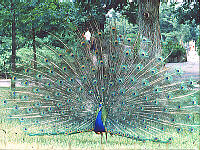 One source of competition in animals is competition for mates, and elaborate
courtship rituals have evolved to demonstrate fitness. Often males fight
over harems of females or to “convince” a watching female that each is
genetically superior to any other nearby males. Many birds use fancy displays,
including brightly-colored feathers, “dances,” etc. to “show off” for the
opposite sex. Sexual selection is selective pressure by members of
the opposite sex. For example, perhaps the females of a certain species of
bird prefer a male who is brightly-colored or who has an extremely-long tail.
Sexual selection may actually work in the opposite direction of natural
selection, as when, for example, that same brightly-colored or long-tailed
male is thereby more visible and vulnerable to predators. In spiders,
special drumming patterns used in species-specific courship rituals help to
distinguish a courting male from dinner!
One source of competition in animals is competition for mates, and elaborate
courtship rituals have evolved to demonstrate fitness. Often males fight
over harems of females or to “convince” a watching female that each is
genetically superior to any other nearby males. Many birds use fancy displays,
including brightly-colored feathers, “dances,” etc. to “show off” for the
opposite sex. Sexual selection is selective pressure by members of
the opposite sex. For example, perhaps the females of a certain species of
bird prefer a male who is brightly-colored or who has an extremely-long tail.
Sexual selection may actually work in the opposite direction of natural
selection, as when, for example, that same brightly-colored or long-tailed
male is thereby more visible and vulnerable to predators. In spiders,
special drumming patterns used in species-specific courship rituals help to
distinguish a courting male from dinner!
Animals also compete with both members of the same species and
with other species for resources/food, hiding places to avoid predators, and
in defense of territory, young, and/or nest sites. Plants also have ways of
competing with other nearby plants for soil nutrients and water or for access
to sunlight. As mentioned above, some plants secrete allopathic chemicals
into the soil to inhibit the growth of or kill other nearby plants. Spring
wildflowers have “solved the problem” of competing with trees for sunlight by
emerging early in spring so they can bloom and begin to set seed and so their
leaves can make food (which is typically stored in the roots or corm for the
following year) before the tree leaves develop.
Defense Mechanisms
| Goat |
|
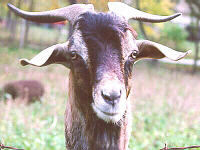 |
|
| horns |
|
| Ladybug |
Yellowjacket |
Locust Borer |
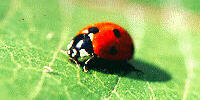 |
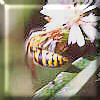 |
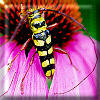 |
| warning coloration |
model |
mimic |
| Dead-Leaf Butterfly |
Monarch Butterfly |
 |
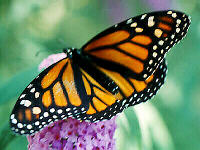 |
| camouflage |
warning coloration |
| Black Swallowtail Caterpillar |
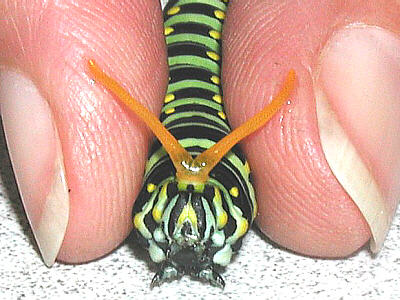 |
| chemical defense (note the liquid being deposited on my fingers) |
Animals possess various defense mechanisms which may be used
in both intraspecific and/or interspecific competition. Some can attack
intruders using teeth, claws, antlers or horns, stingers, and/or chemical
means. Some, such as the previously-mentioned Peppered Moth, use camouflage
to hide, while others use mimicry to resemble dangerous or unpalatable
species, such as the resemblance between the Locust Borer (a beetle) and a
yellowjacket, or the resemblance between Viceroy and Monarch butterflies.
Noxious or unpalatable species, such as arrow poison frogs, Monarch
butterflies, bees, and ladybugs, actually advertise that fact with warning
coloration. Typically these species have stripes or spots of bright red,
orange, or yellow with black. Swallowtail butterfly caterpillars have a
scent gland called an osmeterium tucked into their prothorax, just
behind the head. When disturbed, the caterpillar everts this gland,
suddenly releasing an unpleasant-smelling mixture of isobutyric and
2-methyl butyric acids.
References
(osmeterial secretions)
Borror and Delong, 3rd Ed, p 424
http://creatures.ifas.ufl.edu/CITRUS/GiantSwallowtail.htm
http://creatures.ifas.ufl.edu/bfly/zebra_swallowtail.htm
http://users.chariot.net.au/~rbg/aegeus_ds.htm
http://users.chariot.net.au/~rbg/anactus_ds.htm
Copyright © 1999 by J. Stein Carter. All rights reserved.
This page has been accessed  times since 25 Jun 2001.
times since 25 Jun 2001.
 Intraspecific interactions
are interactions among organisms of the same species. Members of a group
must be able to communicate with each other to stay in touch with others in
the group. Many animals use vocal communication of some sort while both
plants and animals use various chemical signals to communicate with each
other. In animals, these chemicals are generally called
pheromones
and are used for chemical communication over a distance (these are analogous
to hormones within the body). There are various kinds of pheromones
including things like sex pheromones in a variety of insects (used in gypsy
moth traps), trail pheromones in ants (remember the ants in It’s a Bug’s
Life following the trail?), alarm pheromones in ants (and probably some
other insects, too), and others in other animals, including humans. Plants
often secrete inhibitory chemicals into the surrounding soil to prevent the
growth of other plants nearby. This is called
allelopathy.
Amur Honeysuckle and Black Walnut are two species that are especially
notorious for producing allelopathic chemicals.
Intraspecific interactions
are interactions among organisms of the same species. Members of a group
must be able to communicate with each other to stay in touch with others in
the group. Many animals use vocal communication of some sort while both
plants and animals use various chemical signals to communicate with each
other. In animals, these chemicals are generally called
pheromones
and are used for chemical communication over a distance (these are analogous
to hormones within the body). There are various kinds of pheromones
including things like sex pheromones in a variety of insects (used in gypsy
moth traps), trail pheromones in ants (remember the ants in It’s a Bug’s
Life following the trail?), alarm pheromones in ants (and probably some
other insects, too), and others in other animals, including humans. Plants
often secrete inhibitory chemicals into the surrounding soil to prevent the
growth of other plants nearby. This is called
allelopathy.
Amur Honeysuckle and Black Walnut are two species that are especially
notorious for producing allelopathic chemicals.  In r-selection/r-strategy, the organism typically lives in a harsh,
unpredictable environment where mortality is independent of population
density (they die anyway). With characteristics typical of the rising
portion of the logistic curve, these species allocate more energy to
reproduction and less to growth and maintenance. Typically, they exhibit
rapid development and early maturity. Most only reproduce one time and
produce a large number of offspring to make up for the large number of
offspring which die. In animals, there is minimal, if any, parental care of
the young, and in plants, seeds are provided with minimal stored food.
In r-selection/r-strategy, the organism typically lives in a harsh,
unpredictable environment where mortality is independent of population
density (they die anyway). With characteristics typical of the rising
portion of the logistic curve, these species allocate more energy to
reproduction and less to growth and maintenance. Typically, they exhibit
rapid development and early maturity. Most only reproduce one time and
produce a large number of offspring to make up for the large number of
offspring which die. In animals, there is minimal, if any, parental care of
the young, and in plants, seeds are provided with minimal stored food.
 In K-selection/K-strategy, the organism typically lives in a stable,
predictable environment where mortality is related to population density (if
overcrowded, more die due to increased competition). With characteristics
typical of a population maintained at carrying capacity (hence the
K), these species allocate more energy to non-reproductive activities.
Typically they exhibit delayed reproduction (later in life) with slower
development and a longer life span. There is repeated reproduction with
only a few offspring produced each time. In animals, there is often parental
care of the young, and in plants, seeds are produced with much stored
food.
In K-selection/K-strategy, the organism typically lives in a stable,
predictable environment where mortality is related to population density (if
overcrowded, more die due to increased competition). With characteristics
typical of a population maintained at carrying capacity (hence the
K), these species allocate more energy to non-reproductive activities.
Typically they exhibit delayed reproduction (later in life) with slower
development and a longer life span. There is repeated reproduction with
only a few offspring produced each time. In animals, there is often parental
care of the young, and in plants, seeds are produced with much stored
food.

 One source of competition in animals is competition for mates, and elaborate
courtship rituals have evolved to demonstrate fitness. Often males fight
over harems of females or to “convince” a watching female that each is
genetically superior to any other nearby males. Many birds use fancy displays,
including brightly-colored feathers, “dances,” etc. to “show off” for the
opposite sex. Sexual selection is selective pressure by members of
the opposite sex. For example, perhaps the females of a certain species of
bird prefer a male who is brightly-colored or who has an extremely-long tail.
Sexual selection may actually work in the opposite direction of natural
selection, as when, for example, that same brightly-colored or long-tailed
male is thereby more visible and vulnerable to predators. In spiders,
special drumming patterns used in species-specific courship rituals help to
distinguish a courting male from dinner!
One source of competition in animals is competition for mates, and elaborate
courtship rituals have evolved to demonstrate fitness. Often males fight
over harems of females or to “convince” a watching female that each is
genetically superior to any other nearby males. Many birds use fancy displays,
including brightly-colored feathers, “dances,” etc. to “show off” for the
opposite sex. Sexual selection is selective pressure by members of
the opposite sex. For example, perhaps the females of a certain species of
bird prefer a male who is brightly-colored or who has an extremely-long tail.
Sexual selection may actually work in the opposite direction of natural
selection, as when, for example, that same brightly-colored or long-tailed
male is thereby more visible and vulnerable to predators. In spiders,
special drumming patterns used in species-specific courship rituals help to
distinguish a courting male from dinner! 





